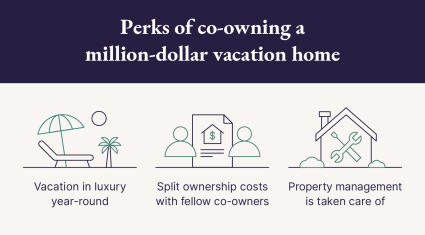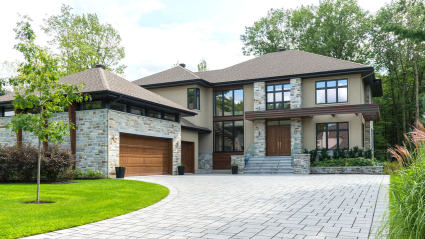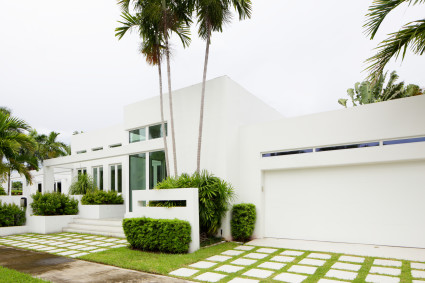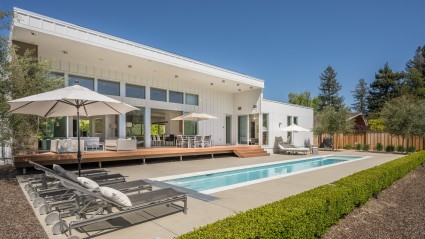Key financials to afford a million-dollar house
To comfortably afford a home valued at $1 million, financial experts recommend an annual salary between $269,000 and $366,000. This range, however, is subject to variation depending on your:- Annual income
- Debt-to-income ratio (DTI)
- Credit score
- Available down payment
- Current interest rates
Examples of a monthly mortgage payment for a million-dollar home
Even if your after-tax earnings are $200,000 annually, that’s still a quarter of your income going just to principal and interest. If your credit or down payment is low, expect the monthly cost to be substantially more.When it comes to how to afford a million-dollar home, understanding the monthly payment is key. The table below shows how different interest rates impact your monthly principal and interest payments on a $1 million loan. This assumes a 30-year fixed-rate mortgage with a 20% down payment.| Interest rate | Monthly payment(principal and interest only) | Estimated monthly payment (with taxes and insurance) |
|---|---|---|
| 6.5% | $5,057 | $6,515 |
| 7% | $5,322 | $6,780 |
| 7.5% | $5,592 | $7,050 |
Expected and unexpected expenses of owning a million-dollar house
It’s important to plan for expenses beyond the mortgage. Here are a few things to factor in:- Mortgage insurance: Lenders require this if you put down less than 20% on the house. It protects the lender in case you default on your loan.
- Homeowners insurance: This covers your home and personal belongings against damage from things like fire or theft. It's usually required by your lender.
- Property taxes: These are set by the local government and vary by location. They are often a significant annual expense based on the assessed value of the property.
- Homeowners association (HOA) fees: These are mandatory fees for homes in a community with an HOA. They cover the maintenance and upkeep of shared amenities and common areas.
- Maintenance and repairs: You should also budget for regular upkeep and unexpected repairs. A general rule of thumb is to set aside 1-3% of the home's value annually for these costs.
Tax implications of a million-dollar home
You might not anticipate how your new home will affect your income taxes. For example, you can lose potential tax savings if your mortgage interest exceeds the current deduction threshold.The mortgage interest tax deduction has a limit of $750,000, which means that if you put down less than $250,000, you will incur “lost” tax savings each year until your principal loan balance drops below $750,000.If you decide to rent out your $1 million second home, you won’t be able to claim the mortgage interest deduction, but you could end up with tax-free rental income due to the various deductions for landlords. However, this can be a complicated adjustment, and finding renters and managing a rental — or short-term rental property — can be a hassle.Financing strategies to afford a million-dollar house
Financing a mortgage on a million-dollar home doesn’t have to be stressful. In fact, there are three financing strategies available for those who have the income for a million-dollar home."From my experience managing a $10M+ real estate portfolio, I'd say it's actually becoming a decent time to buy — especially in the luxury segment. I'm seeing more negotiating power than we've had in years. The current environment presents some unique opportunities. Inventory's up about 25% in most luxury markets I track, and sellers are getting more flexible." — Andrew Lokenauth, Founder at TheFinanceNewsletter.com
Make a large down payment
Paying a larger down payment upfront can help you minimize the interest you’ll pay on your principal. Although 20% is generally expected by lenders, providing more can help make your bid more competitive and potentially lower your mortgage payments.Get a jumbo mortgage
If your home’s price exceeds the conventional loan limits set by your state — generally over $1 million — you may require financing via a jumbo loan. These non-conforming loans may require a down payment of as little as 5% and are not subject to limits set by Fannie Mae or Freddie Mac. Check with your county and lender to see if you qualify for a jumbo mortgage.Leverage home equity
A home equity loan and a home equity line of credit (HELOC) may help current homeowners pay for a mortgage on a million-dollar house. These financing tools work by leveraging the equity of your primary residence as a means of financing when buying a second home.Liquidate other assets
For some, a key financing strategy involves liquidating assets like stocks, bonds or a current property if you own multiple homes. This provides the cash needed for a substantial down payment, reducing the amount you need to borrow and lowering monthly payments. Using the equity from an existing home is a common way to afford a house and can help secure a better interest rate on a million-dollar house.Co-ownership models
What if your million-dollar dream home is for vacations, not your primary residence? Those are hefty expenses for a home you won’t use year-round. This is why many second home buyers are opting for co-ownership.Prospective second home owners are embracing Pacaso’s fully managed LLC co-ownership model. It offers the benefits of real estate ownership at a lower cost than whole home ownership and without property maintenance and management hassles.Pacaso offers a modern way to buy a million-dollar second home. Our LLC model lets you co-own a luxury second home for as little as one-eighth of the home’s price, increasing your buying power and allowing you to own more house for less money. Pacaso takes care of the home’s maintenance, bill payments and management.
Hassle-free ownership of a million-dollar home
Owning a million-dollar house as a vacation home is more attainable through fractional ownership. By dividing the costs and responsibilities, Pacaso makes luxury home ownership an accessible and straightforward option. This model allows you to enjoy the benefits of a high-end property without the full cost of second home ownership.Check out our listings and learn more about how Pacaso can help you own the million-dollar home of your dreams.How to buy a million-dollar house FAQ
01: Is now a good time to buy a million-dollar home?
Your readiness to buy a million-dollar home depends on your personal finances.
02: How much do you need to make to afford a million-dollar home?
The annual income to afford a million-dollar home is between $269,000 and $366,000 on average.
03: What is a good down payment for a $1 million house?
In general, a 20% down payment is recommended. Putting 20% of the home price down for a million-dollar home results in a $200,000 down payment.
04: What are the benefits of buying a million-dollar house?
Some benefits of buying a million-dollar house include potentially profiting from value appreciation and the ability to retire there when you’re ready to do so. These homes also often come with high-end amenities and premium finishes and are located in desirable, appreciating neighborhoods.
05: What is the 28/36 rule?
The 28% rule refers to the percentage of your gross monthly income you should consider spending on your housing costs. According to this rule, you should only use 28% of your salary for million-dollar home purchases, including interest, taxes and insurance. This is a key factor in determining a comfortable salary to afford a $1.5 million home.
The 36% rule refers to your total debt-to-income ratio. According to this rule, all of your monthly debt payments combined — including housing costs, car payments and credit card bills — should not exceed 36% of your gross monthly income.










